Logistics and supply chain finance: managing financial risks and optimizing financial flows in logistics and supply chains
Logistics and supply chain management (SCM) play more and more important roles in
modern world and have great potential for improving bottom line results. In the literature, there are a lot
of contributions towards managing physical risks, information and goods flows while issues related to
managing financial risks such as market risk, credit risk, currency risk and optimizing financial flows
have not been discussed adequately. This article will focus on this research gap to enhance efficiency of
logistics and supply chains by applying finance to develop the framework to optimize cost flows of those
companies taking capital structure, cost of capital and various cost drivers into consideration and also
recommending the use of derivatives such as forward or future contracts, swaps, option to hedge
different financial risks that logistics and supply chain companies may face in global context.
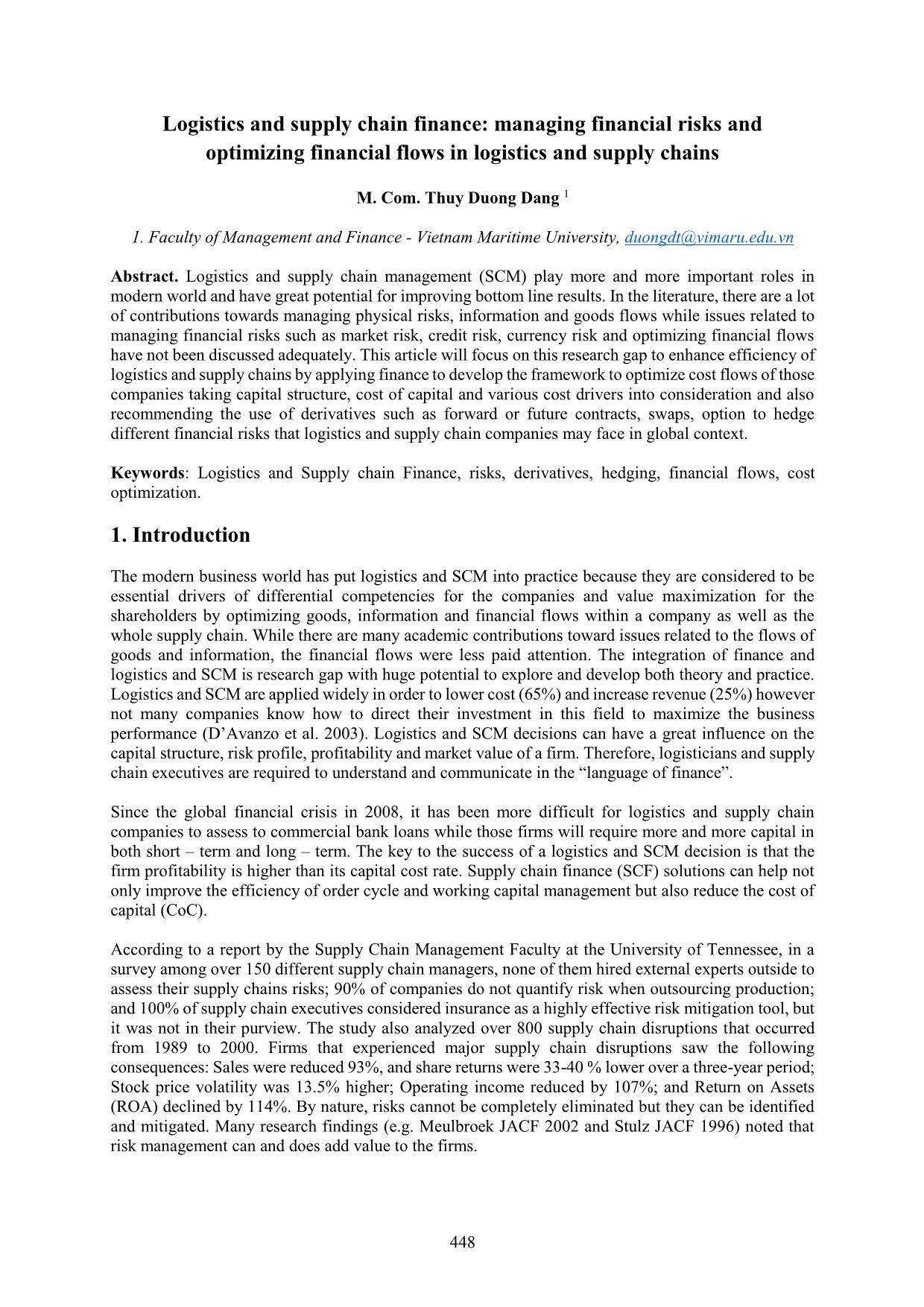
Trang 1
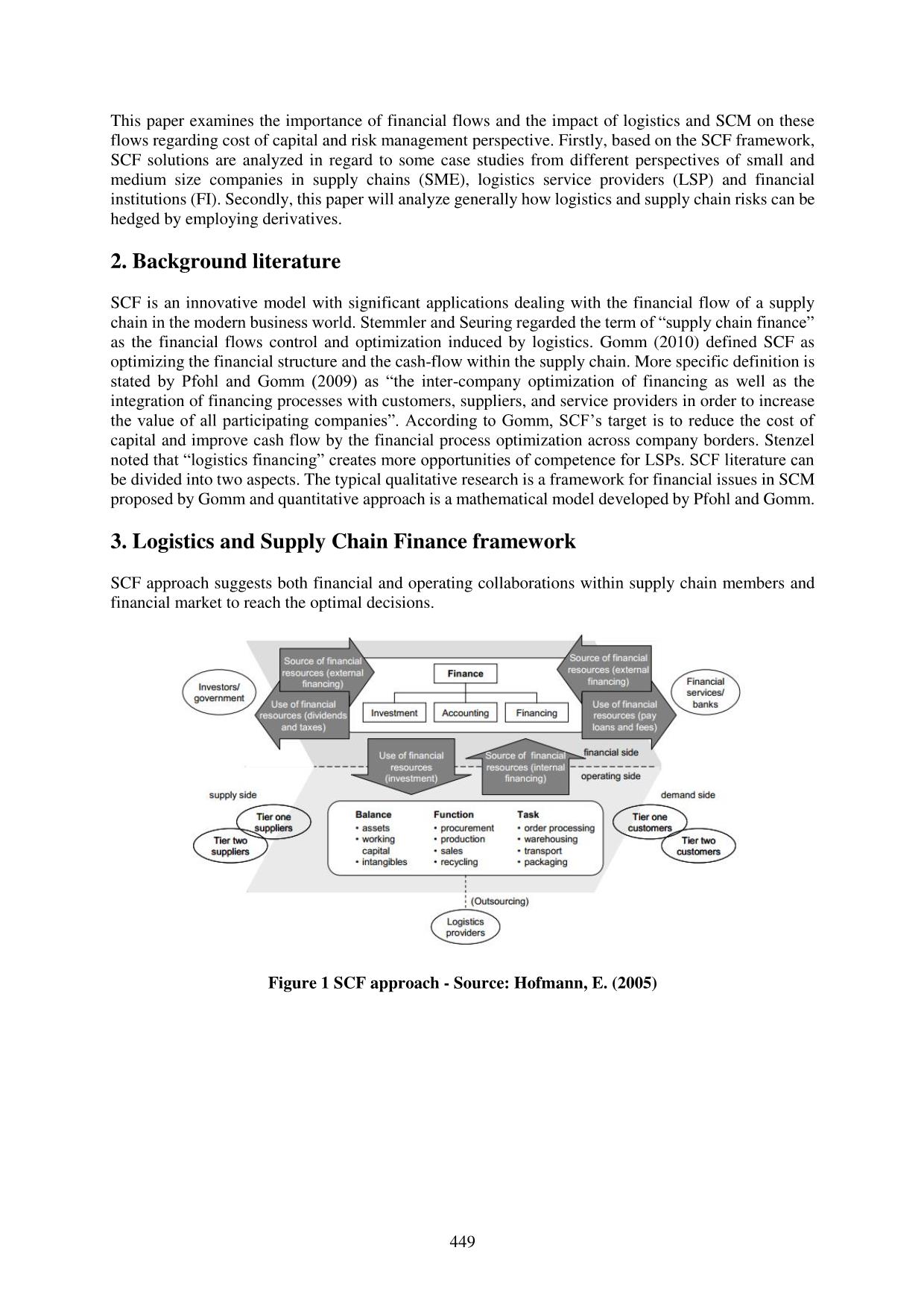
Trang 2
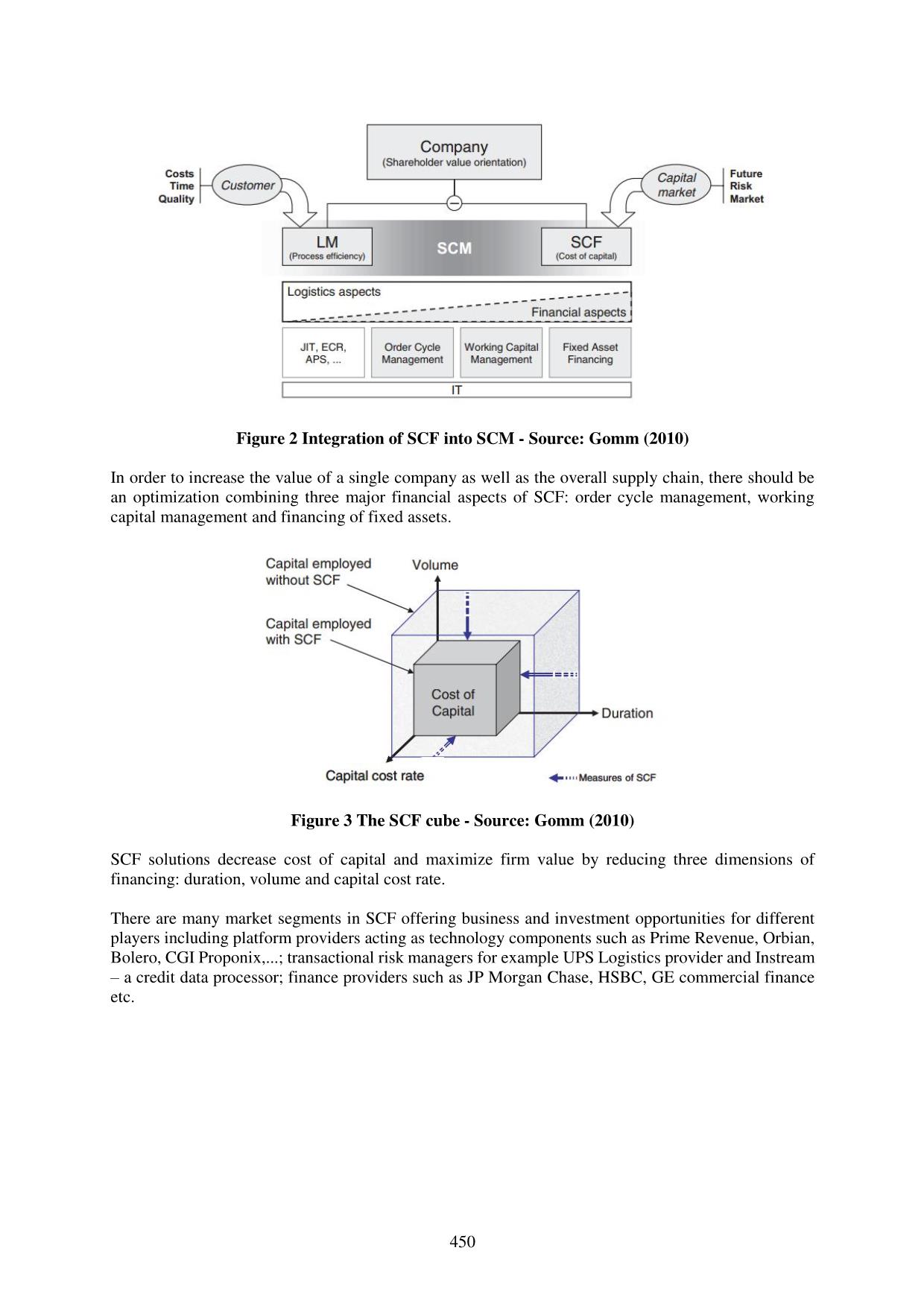
Trang 3
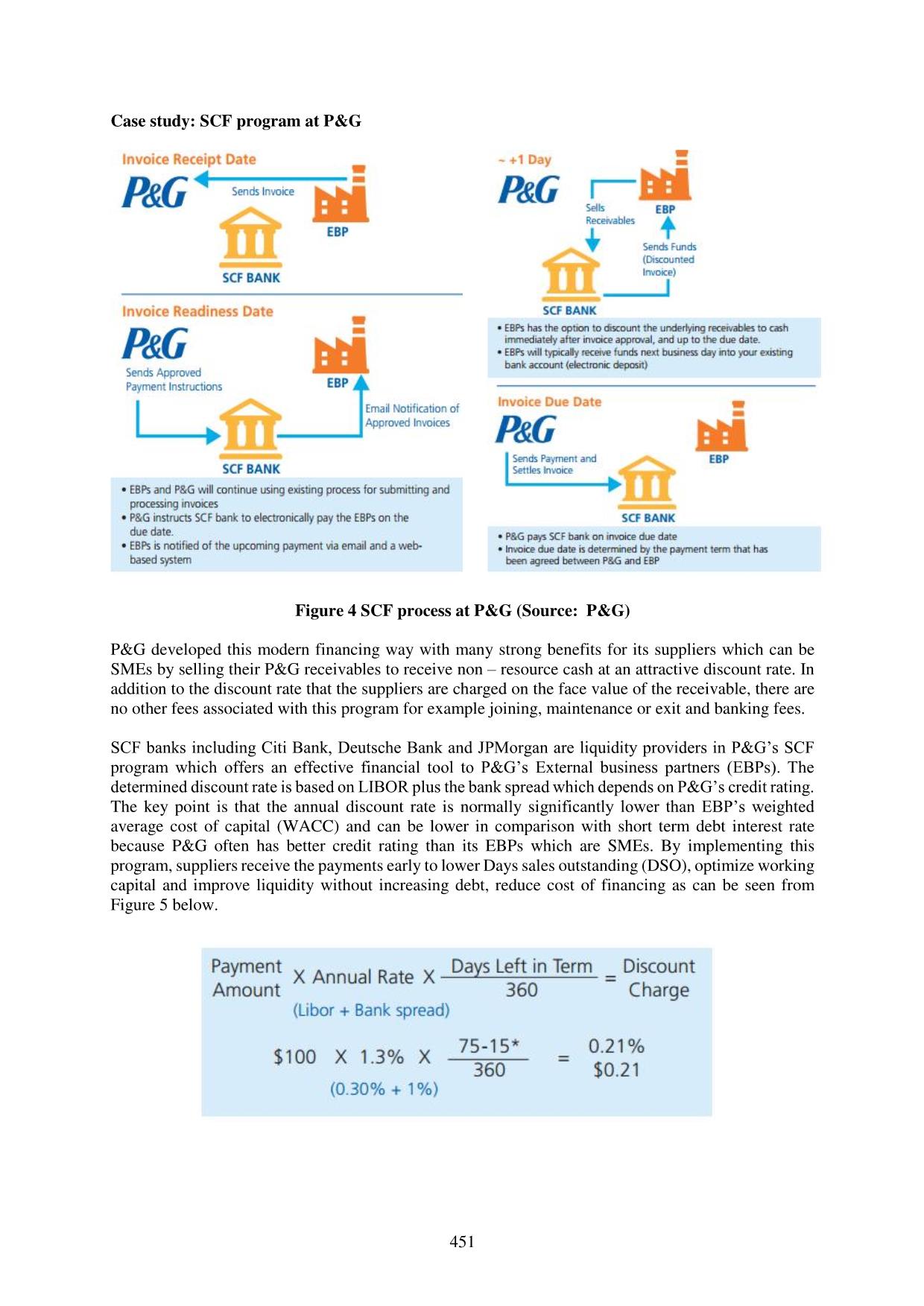
Trang 4
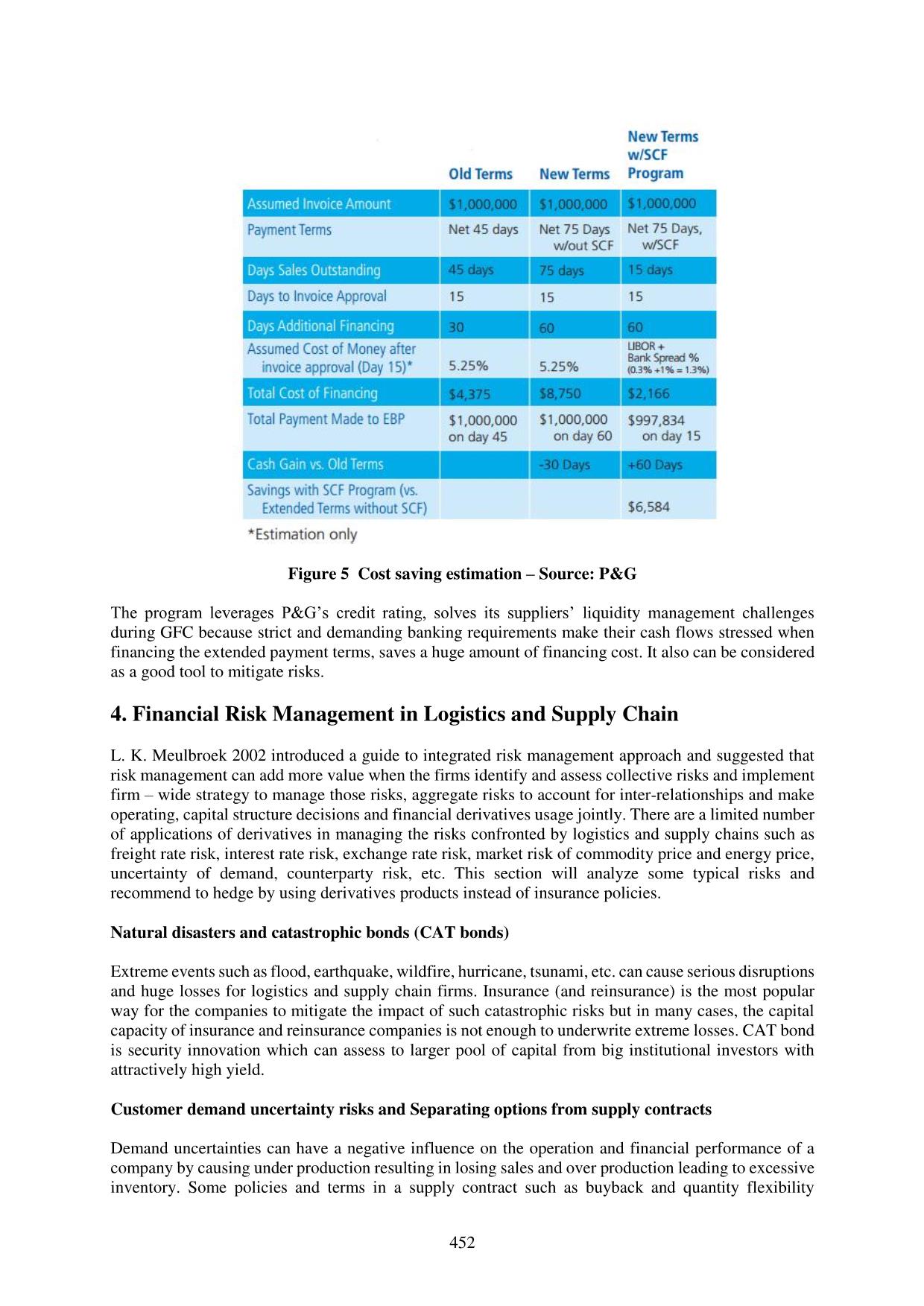
Trang 5
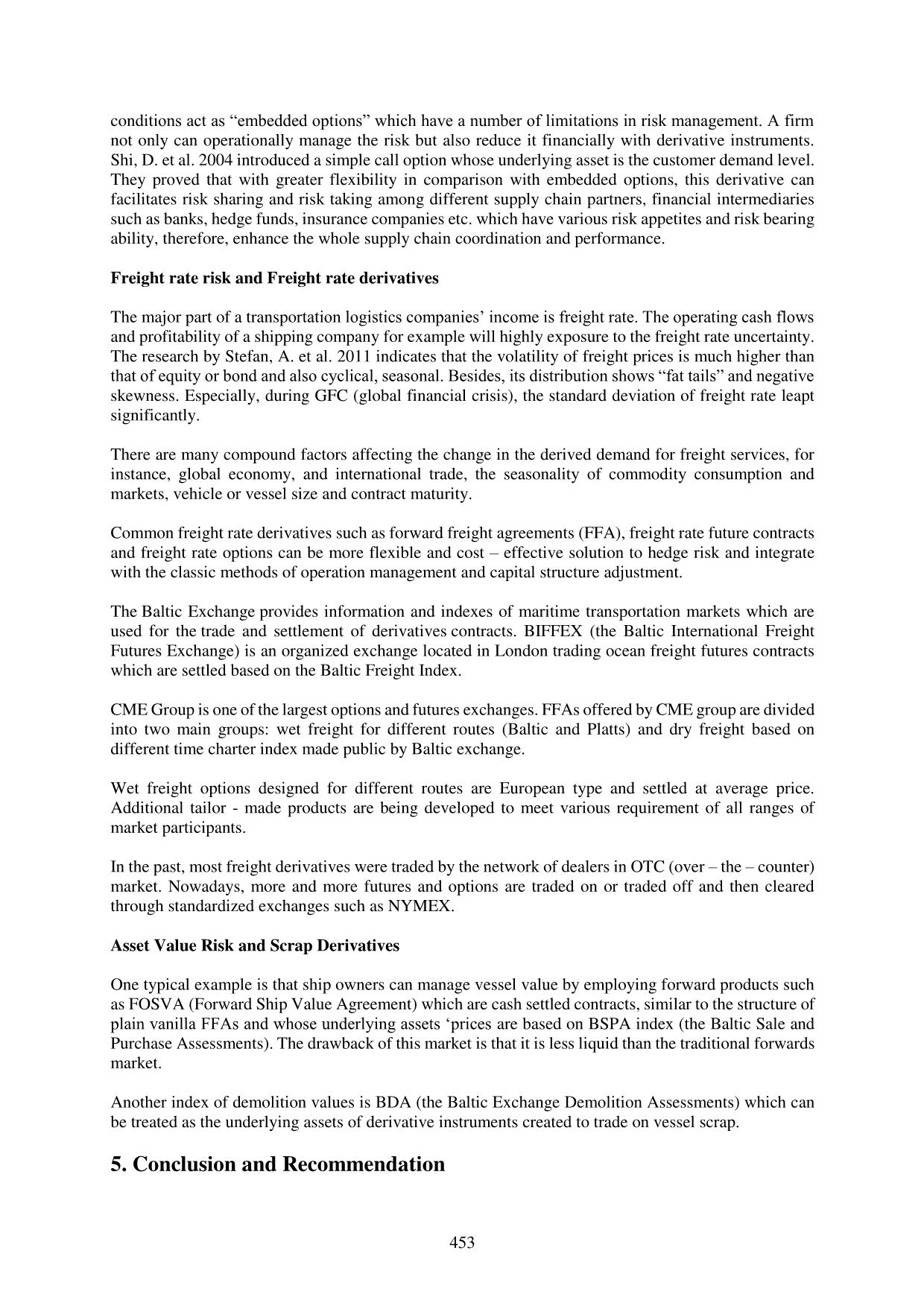
Trang 6
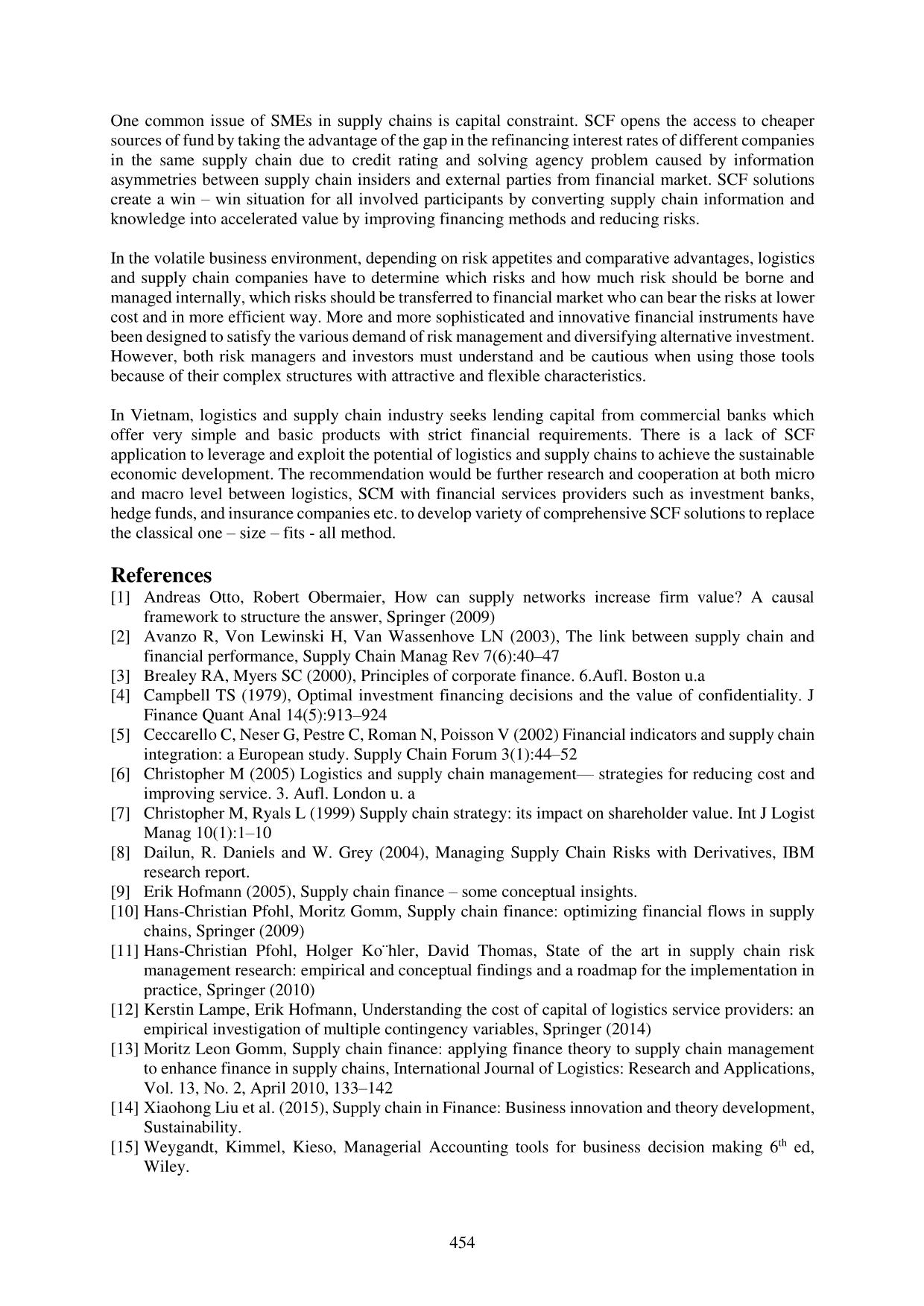
Trang 7
Tóm tắt nội dung tài liệu: Logistics and supply chain finance: managing financial risks and optimizing financial flows in logistics and supply chains
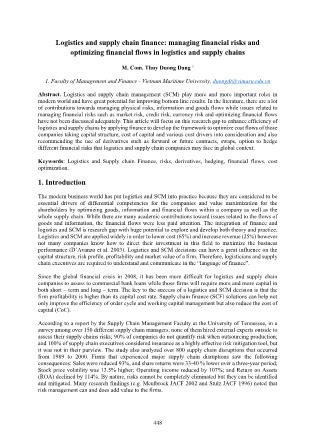
448 Logistics and supply chain finance: managing financial risks and optimizing financial flows in logistics and supply chains M. Com. Thuy Duong Dang 1 1. Faculty of Management and Finance - Vietnam Maritime University, duongdt@vimaru.edu.vn Abstract. Logistics and supply chain management (SCM) play more and more important roles in modern world and have great potential for improving bottom line results. In the literature, there are a lot of contributions towards managing physical risks, information and goods flows while issues related to managing financial risks such as market risk, credit risk, currency risk and optimizing financial flows have not been discussed adequately. This article will focus on this research gap to enhance efficiency of logistics and supply chains by applying finance to develop the framework to optimize cost flows of those companies taking capital structure, cost of capital and various cost drivers into consideration and also recommending the use of derivatives such as forward or future contracts, swaps, option to hedge different financial risks that logistics and supply chain companies may face in global context. Keywords: Logistics and Supply chain Finance, risks, derivatives, hedging, financial flows, cost optimization. 1. Introduction The modern business world has put logistics and SCM into practice because they are considered to be essential drivers of differential competencies for the companies and value maximization for the shareholders by optimizing goods, information and financial flows within a company as well as the whole supply chain. While there are many academic contributions toward issues related to the flows of goods and information, the financial flows were less paid attention. The integration of finance and logistics and SCM is research gap with huge potential to explore and develop both theory and practice. Logistics and SCM are applied widely in order to lower cost (65%) and increase revenue (25%) however not many companies know how to direct their investment in this field to maximize the business performance (D’Avanzo et al. 2003). Logistics and SCM decisions can have a great influence on the capital structure, risk profile, profitability and market value of a firm. Therefore, logisticians and supply chain executives are required to understand and communicate in the “language of finance”. Since the global financial crisis in 2008, it has been more difficult for logistics and supply chain companies to assess to commercial bank loans while those firms will require more and more capital in both short – term and long – term. The key to the success of a logistics and SCM decision is that the firm profitability is higher than its capital cost rate. Supply chain finance (SCF) solutions can help not only improve the efficiency of order cycle and working capital management but also reduce the cost of capital (CoC). According to a report by the Supply Chain Management Faculty at the University of Tennessee, in a survey among over 150 different supply chain managers, none of them hired external experts outside to assess their supply chains risks; 90% of companies do not quantify risk when outsourcing production; and 100% of supply chain executives considered insurance as a highly effective risk mitigation tool, but it was not in their purview. The study also analyzed over 800 supply chain disruptions that occurred from 1989 to 2000. Firms that experienced major supply chain disruptions saw the following consequences: Sales were reduced 93%, and share returns were 33-40 % lower over a three-year period; Stock price volatility was 13.5% higher; Operating income reduced by 107%; and Return on Assets (ROA) declined by 114%. By nature, risks cannot be completely eliminated but they can be identified and mitigated. Many research findings (e.g. Meulbroek JACF 2002 and Stulz JACF 1996) noted that risk management can and does add value to the firms. 449 This paper examines the importance of financial flows and the impact of logistics and SCM on these flows regarding cost of capital and risk management perspective. Firstly, based on the SCF framework, SCF solutions are analyzed in regard to some case studies from different perspectives of small and medium size companies in supply chains (SME), logistics service providers (LSP) and financial institutions (FI). Secondly, this paper will analyze generally how logistics and supply chain risks can be hedged by employing derivatives. 2. Background literature SCF is an innovative model with significant applications dealing with the financial flow of a supply chain in the modern business world. Stemmler and Seuring regarded the term of “supply chain finance” as the financial flows control and optimization induced by logistics. Gomm (2010) defined SCF as optimizing the financial structure and the cash-flow within the supply chain. More specific definition is stated by Pfohl and Gomm (2009) as “the inter-company optimization of financing as well as the integration of financing processes with customers, suppliers, and service providers in order to increase the value of all participating companies”. According to Gomm, SCF’s target is to reduce the cost of capital and improve cash flow by the financial process optimization across company borders. Stenzel noted that “logistics financing” creates more opportunities of competence for LSPs. SCF literature can be divided into two aspects. The typical qualitative research is a framework for financial issues in SCM proposed by Gomm and quantitative approach is a mathematical model developed by Pfohl and Gomm. 3. Logistics and Supply Chain Finance framework SCF approach suggests both financial and operating collaborations within supply chain members and financial market to reach the optimal decisions. Figure 1 SCF approach - Source: Hofmann, E. (2005) 450 Figure 2 Integration of SCF into SCM - Source: Gomm (2010) In order to increase the value of a single company as well as the overall supply chain, there should be an optimization combining three major financial aspects of SCF: order cycle management, working capital management and financing of fixed assets. Figure 3 The SCF cube - Source: Gomm (2010) SCF solutions decrease cost of capital and maximize firm value by reducing three dimensions of financing: duration, volume and capital cost rate. There are many market segments in SCF offering business and investment opportunities for different players including platform providers acting as technology components such as Prime Revenue, Orbian, Bolero, CGI Proponix,...; transactional risk managers for example UPS Logistics provider and Instream – a credit data processor; finance providers such as JP Morgan Chase, HSBC, GE commercial finance etc. 451 Case study: SCF program at P&G Figure 4 SCF process at P&G (Source: P&G) P&G developed this modern financing way with many strong benefits for its suppliers which can be SMEs by selling their P&G receivables to receive non – resource cash at an attractive discount rate. In addition to the discount rate that the suppliers are charged on the face value of the receivable, there are no other fees associated with this program for example joining, maintenance or exit and banking fees. SCF banks including Citi Bank, Deutsche Bank and JPMorgan are liquidity providers in P&G’s SCF program which offers an effective financial tool to P&G’s External business partners (EBPs). The determined discount rate is based on LIBOR plus the bank spread which depends on P&G’s credit rating. The key point is that the annual discount rate is normally significantly lower than EBP’s weighted average cost of capital (WACC) and can be lower in comparison with short term debt interest rate because P&G often has better credit rating than its EBPs which are SMEs. By implementing this program, suppliers receive the payments early to lower Days sales outstanding (DSO), optimize working capital and improve liquidity without increasing debt, reduce cost of financing as can be seen from Figure 5 below. 452 Figure 5 Cost saving estimation – Source: P&G The program leverages P&G’s credit rating, solves its suppliers’ liquidity management challenges during GFC because strict and demanding banking requirements make their cash flows stressed when financing the extended payment terms, saves a huge amount of financing cost. It also can be considered as a good tool to mitigate risks. 4. Financial Risk Management in Logistics and Supply Chain L. K. Meulbroek 2002 introduced a guide to integrated risk management approach and suggested that risk management can add more value when the firms identify and assess collective risks and implement firm – wide strategy to manage those risks, aggregate risks to account for inter-relationships and make operating, capital structure decisions and financial derivatives usage jointly. There are a limited number of applications of derivatives in managing the risks confronted by logistics and supply chains such as freight rate risk, interest rate risk, exchange rate risk, market risk of commodity price and energy price, uncertainty of demand, counterparty risk, etc. This section will analyze some typical risks and recommend to hedge by using derivatives products instead of insurance policies. Natural disasters and catastrophic bonds (CAT bonds) Extreme events such as flood, earthquake, wildfire, hurricane, tsunami, etc. can cause serious disruptions and huge losses for logistics and supply chain firms. Insurance (and reinsurance) is the most popular way for the companies to mitigate the impact of such catastrophic risks but in many cases, the capital capacity of insurance and reinsurance companies is not enough to underwrite extreme losses. CAT bond is security innovation which can assess to larger pool of capital from big institutional investors with attractively high yield. Customer demand uncertainty risks and Separating options from supply contracts Demand uncertainties can have a negative influence on the operation and financial performance of a company by causing under production resulting in losing sales and over production leading to excessive inventory. Some policies and terms in a supply contract such as buyback and quantity flexibility 453 conditions act as “embedded options” which have a number of limitations in risk management. A firm not only can operationally manage the risk but also reduce it financially with derivative instruments. Shi, D. et al. 2004 introduced a simple call option whose underlying asset is the customer demand level. They proved that with greater flexibility in comparison with embedded options, this derivative can facilitates risk sharing and risk taking among different supply chain partners, financial intermediaries such as banks, hedge funds, insurance companies etc. which have various risk appetites and risk bearing ability, therefore, enhance the whole supply chain coordination and performance. Freight rate risk and Freight rate derivatives The major part of a transportation logistics companies’ income is freight rate. The operating cash flows and profitability of a shipping company for example will highly exposure to the freight rate uncertainty. The research by Stefan, A. et al. 2011 indicates that the volatility of freight prices is much higher than that of equity or bond and also cyclical, seasonal. Besides, its distribution shows “fat tails” and negative skewness. Especially, during GFC (global financial crisis), the standard deviation of freight rate leapt significantly. There are many compound factors affecting the change in the derived demand for freight services, for instance, global economy, and international trade, the seasonality of commodity consumption and markets, vehicle or vessel size and contract maturity. Common freight rate derivatives such as forward freight agreements (FFA), freight rate future contracts and freight rate options can be more flexible and cost – effective solution to hedge risk and integrate with the classic methods of operation management and capital structure adjustment. The Baltic Exchange provides information and indexes of maritime transportation markets which are used for the trade and settlement of derivatives contracts. BIFFEX (the Baltic International Freight Futures Exchange) is an organized exchange located in London trading ocean freight futures contracts which are settled based on the Baltic Freight Index. CME Group is one of the largest options and futures exchanges. FFAs offered by CME group are divided into two main groups: wet freight for different routes (Baltic and Platts) and dry freight based on different time charter index made public by Baltic exchange. Wet freight options designed for different routes are European type and settled at average price. Additional tailor - made products are being developed to meet various requirement of all ranges of market participants. In the past, most freight derivatives were traded by the network of dealers in OTC (over – the – counter) market. Nowadays, more and more futures and options are traded on or traded off and then cleared through standardized exchanges such as NYMEX. Asset Value Risk and Scrap Derivatives One typical example is that ship owners can manage vessel value by employing forward products such as FOSVA (Forward Ship Value Agreement) which are cash settled contracts, similar to the structure of plain vanilla FFAs and whose underlying assets ‘prices are based on BSPA index (the Baltic Sale and Purchase Assessments). The drawback of this market is that it is less liquid than the traditional forwards market. Another index of demolition values is BDA (the Baltic Exchange Demolition Assessments) which can be treated as the underlying assets of derivative instruments created to trade on vessel scrap. 5. Conclusion and Recommendation 454 One common issue of SMEs in supply chains is capital constraint. SCF opens the access to cheaper sources of fund by taking the advantage of the gap in the refinancing interest rates of different companies in the same supply chain due to credit rating and solving agency problem caused by information asymmetries between supply chain insiders and external parties from financial market. SCF solutions create a win – win situation for all involved participants by converting supply chain information and knowledge into accelerated value by improving financing methods and reducing risks. In the volatile business environment, depending on risk appetites and comparative advantages, logistics and supply chain companies have to determine which risks and how much risk should be borne and managed internally, which risks should be transferred to financial market who can bear the risks at lower cost and in more efficient way. More and more sophisticated and innovative financial instruments have been designed to satisfy the various demand of risk management and diversifying alternative investment. However, both risk managers and investors must understand and be cautious when using those tools because of their complex structures with attractive and flexible characteristics. In Vietnam, logistics and supply chain industry seeks lending capital from commercial banks which offer very simple and basic products with strict financial requirements. There is a lack of SCF application to leverage and exploit the potential of logistics and supply chains to achieve the sustainable economic development. The recommendation would be further research and cooperation at both micro and macro level between logistics, SCM with financial services providers such as investment banks, hedge funds, and insurance companies etc. to develop variety of comprehensive SCF solutions to replace the classical one – size – fits - all method. References [1] Andreas Otto, Robert Obermaier, How can supply networks increase firm value? A causal framework to structure the answer, Springer (2009) [2] Avanzo R, Von Lewinski H, Van Wassenhove LN (2003), The link between supply chain and financial performance, Supply Chain Manag Rev 7(6):40–47 [3] Brealey RA, Myers SC (2000), Principles of corporate finance. 6.Aufl. Boston u.a [4] Campbell TS (1979), Optimal investment financing decisions and the value of confidentiality. J Finance Quant Anal 14(5):913–924 [5] Ceccarello C, Neser G, Pestre C, Roman N, Poisson V (2002) Financial indicators and supply chain integration: a European study. Supply Chain Forum 3(1):44–52 [6] Christopher M (2005) Logistics and supply chain management— strategies for reducing cost and improving service. 3. Aufl. London u. a [7] Christopher M, Ryals L (1999) Supply chain strategy: its impact on shareholder value. Int J Logist Manag 10(1):1–10 [8] Dailun, R. Daniels and W. Grey (2004), Managing Supply Chain Risks with Derivatives, IBM research report. [9] Erik Hofmann (2005), Supply chain finance – some conceptual insights. [10] Hans-Christian Pfohl, Moritz Gomm, Supply chain finance: optimizing financial flows in supply chains, Springer (2009) [11] Hans-Christian Pfohl, Holger Ko¨hler, David Thomas, State of the art in supply chain risk management research: empirical and conceptual findings and a roadmap for the implementation in practice, Springer (2010) [12] Kerstin Lampe, Erik Hofmann, Understanding the cost of capital of logistics service providers: an empirical investigation of multiple contingency variables, Springer (2014) [13] Moritz Leon Gomm, Supply chain finance: applying finance theory to supply chain management to enhance finance in supply chains, International Journal of Logistics: Research and Applications, Vol. 13, No. 2, April 2010, 133–142 [14] Xiaohong Liu et al. (2015), Supply chain in Finance: Business innovation and theory development, Sustainability. [15] Weygandt, Kimmel, Kieso, Managerial Accounting tools for business decision making 6th ed, Wiley.
File đính kèm:
 logistics_and_supply_chain_finance_managing_financial_risks.pdf
logistics_and_supply_chain_finance_managing_financial_risks.pdf

